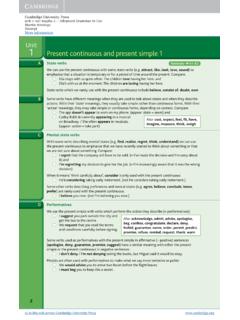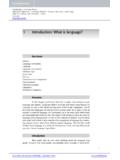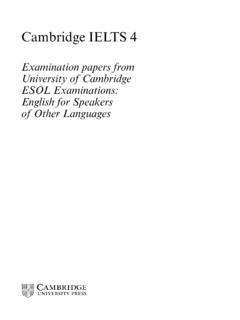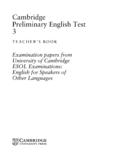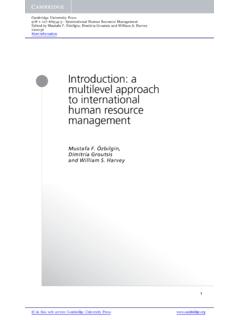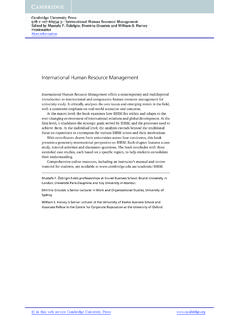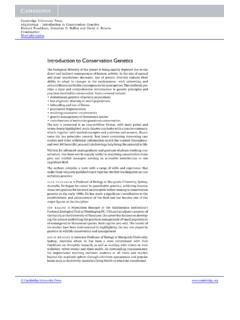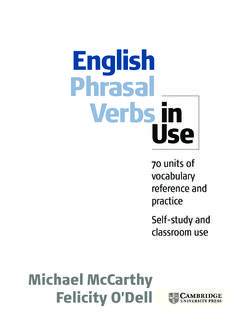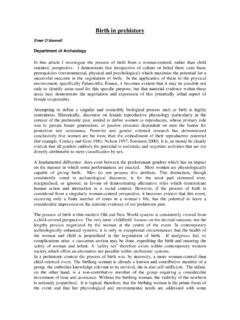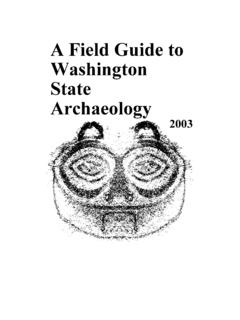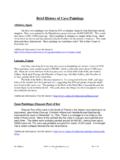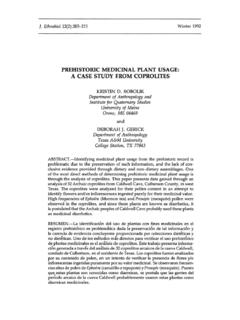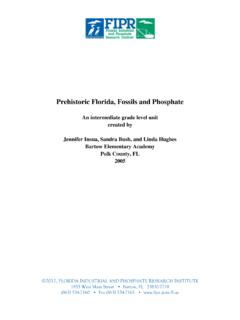Transcription of Prehistoric - Assets
1 PrehistoricThe only street-name in Cambridge that has connections withprehistoric times is ARBURY Road. The name is spelledHerburg, Ertburg, and similarly in thirteenth-century docu-ments, and means earthwork. It used to be thought that ArburyCamp, at the north end o fthe road, was a fort like the one atWandlebury or the War Ditches on LIME KILN Hill, south ofthe reservoir (now destroyed), but it is today regarded as anundefended site. A low circular bank and ditch about 100 metresin diameter, it was almost certainly an Iron Age enclosure forkeeping animals safe from wolves and robbers. (See AlisonTaylor, Prehistoric Cambridgeshire, 1977, and Sallie Purkis,Arbury Is Where We Live, EARO, The Resource Centre, BackHill, Ely, 1981.)RomanIn the latefirst century Catuvellaunian settlers createda village on the spur o fCASTLE hill.
2 This was abandonedat the time o fthe Roman conquest, and between 43 and 70 the Romans built a military camp there. TheCatuvellaunians may have taken part in the rebellion ofBoadicea after 60 ,orhavesuffered for it. The Romans werenot there to tolerate insubordination. (See David J. Breeze,Roman Forts in Britain, 1994.)1 Cambridge University University Press0521789567 - Cambridge Street-Names: Their Origins and AssociationsRonald Gray and Derek StubbingsExcerptMore informationThe Roman castrum was bounded on two sides by the lineo fMOUNT PLEASANT, where there was a wall and a turned at a right angle and probably continued acrossHUNTINGDON Road to CLARE Street and back down theline o fMAGRATH Avenue to near CHESTERTON Lane,turning to the south-west through KETTLE S YARD and thennorth-west up HONEY HILL.
3 The last o fthese is a name o ftenfound, making a rustic joke about a particularly muddy place,not much like honey. However, local residents prefer the namePooh Corner, alluding to the great bear s favourite was a former owner. (See David M. Browne, RomanCambridgeshire, 1977; also Mac Dowdy,Romans in the CambridgeArea, Cambridge Antiquarian Society, Excavation at Shire Hall,1983.)A gate to the Roman camp was slightly to the north-west ofALBION Row. Here the legions marched in to their Lane derives its name from ceastre , orig-inally the Roman camp or castrum . (Chesterton was for manycenturies separate administratively from Cambridge, as isimplied by the Victoria Bridge, which has the Cambridge armson the south side, and the equivalent for Chesterton on thenorth.)
4 It included the medieval castle.) A Roman road fromErmine Street near Wimpole passed through Barton and con-tinued north-east o fthe camp. It is called AKEMAN Street, butthe street that now has this name is at right angles to the originalone, which followed almost exactly the line of STRETTEN(sometimes spelled STRETTON) Avenue, evidently nameda fter a Chie fConstable o fCambridgeshire (Charles JamesDerrickson Stretten, born in 1830, who was connected with StLUKE S Church, near his HQ, as were several others such asthose named in HALE and SEARLE Street, and HARVEY - 2 Cambridge University University Press0521789567 - Cambridge Street-Names: Their Origins and AssociationsRonald Gray and Derek StubbingsExcerptMore informationGOODWIN Avenue.
5 Less likely is the first Master o fTrinityHall, Robert Stretton, who resigned in 1355.) At CARLTONWay the line o fthe Roman road is followed exactly; the name isthat o fHenry Boyle, first Lord Carlton, who died in 1725, wasMP for Cambridge University 1692 1705 and Chancellor of theExchequer in 1701. His coat-of-arms appeared on the inn-signo fthe Carlton Arms until Street continues in MERE Way, near the city bound-ary mere being a name often used for a boundary or division and then in a straight line, becoming a track up which thelegions marched towards Ely; beyond there the road led toDenver and the coast at Brancaster. Akeman was derived byantiquarians, without justification, from Acemanes-ceastre , anancient name for course o fthe Roman road from the south is now markedby the part o fHILLS Road beginning at STATION Road, con-tinuing in REGENT Street, ST ANDREW S Street, SIDNEYS treet, BRIDGE Street, MAGDALENE Street, CASTLES treet and HUNTINGDON Road.
6 (From STATION Roadsouthwards the old road diverges slightly until WORTS Causeway.) It is often called the Via Devana, but this is again aname mistakenly given by antiquarians who believed it was parto fa road that led from Colchester to recent cluster o fstreet-names straddling the course o ftheRoman road beyond MERE Way is devoted to Roman mythol-ogy and history. AUGUSTUS Close is named after the RomanEmperor (63 14 ), APOLLO Way after the Roman godo fthe sun, NEPTUNE Close a fter the god o fthe sea,MINERVA Way after the goddess of wisdom and of arts andtrades, who was also the goddess o fwar. HERCULES Close isnamed after the fantastically strong hero who was proclaimed aRoman3 Cambridge University University Press0521789567 - Cambridge Street-Names: Their Origins and AssociationsRonald Gray and Derek StubbingsExcerptMore informationgod after his death.
7 A bronze statuette of him has been found atSutton-in-the-Isle. (See Miranda J. Green, The Gods of RomanBritain, 1994.) All these names would have been familiar to theoccupants o fthe Roman villa, remains o fwhich have beenfound in an area around FORTESCUE Road andHUMPHREYS Road. It was L-shaped and had three or fourrooms, with a pottery kiln and cemetery. The courts (notstreets) in this area include Roman, Villa, Portico, Pavilion,Forum, Temple, Emperor, Tribune, Consul, Legion and Legate,all with Roman the Romans left Cambridge, their buildings were not pre-served by the Angles, Jutes and Saxons, some o fwhom began toarrive in the late fourth century. For hundreds of years therewere raids and pillagings, especially by the the seventh century, according to ST BEDE (673 735), thehistorian o fthe English church and people, there was a littleruined city called Grantchester [ Cambridge] , where monksdiscovered a stone coffin to enshrine the bones o fSt Etheldreda,who had founded Ely Cathedral.
8 (There is a window showing StBede in Holy Sepulchre Church.) But despite the raids andbattles, by the time o fDomesday Book nearly all the present dayvillages were in existence, and Cambridge had a church , possibly founded by King Canute. (See AlisonTaylor, Anglo-Saxon Cambridge, 1978.)The names CAMBRIDGE and CAM appear in severalstreet-names. Camboritum was never the name o fthe citybut Durolipons is now suggested by historians as well as Dur- - 4 Cambridge University University Press0521789567 - Cambridge Street-Names: Their Origins and AssociationsRonald Gray and Derek StubbingsExcerptMore informationcinate (or Curcinate ) and the rather ugly Durovigutum . InBede s day it was Grantacaestir, and similar names occur until1170.
9 In 875 three Danes wintered in Grantebrygge, selectingit apparently as a place o fsome importance. Three great shipswith oars, coming along the course o fthe rowing races, are stillvisible to the mind s eye. In about 945 the name Grontabriccoccurs, and similar names continue until 1187. In 1086 Cantebrigie appears, continuing in similar forms till (g)e appears in 1348, and variants o fthis lead on tothe modern form. Thus the Roman fort ( caestir) on theGranta is later the bridge over the Granta ( muddyriver ) . The r was lost, and the G became C , says Reaney, because o fthe inevitable difficulties o fthe Frenchman [ ] in pronouncing a succession o fliquids . (See Reaney,The Place-Names of Cambridgeshire and the Isle of Ely.)
10 Otherwise Cambridge would be Grambridge, but none theworse for is a SAXON Street, and a SAXON Road, the latterbeing near to the supposed hut o fthe Saxon hermit Godesone(God s son), remembered in the mis-spelt GODESDONERoad. Near a holy well going back to pagan times he had awooden oratory dedicated to St Andrew, to whom the church onNewmarket Road is consecrated. (Another hermit sat by thebridge where SILVER Street bridge now is, collecting tolls, ashermits often did, many being no more men of religion thaneighteenth-century toll-keepers were, but the name is unex-plained. There are many Silver Streets, and as Reaney says theycannot all have been occupied by silversmiths but surely aplace like Cambridge needed them?)

